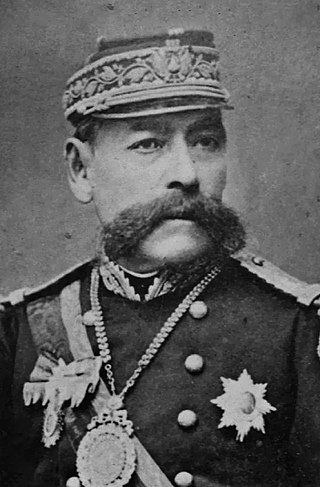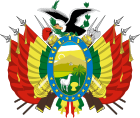
Hugo Banzer Suárez was a Bolivian politician and military officer who served as the 51st president of Bolivia. He held the Bolivian presidency twice: from 1971 to 1978 in a military dictatorship; and then again from 1997 to 2001, as a democratically elected president.

The Revolutionary Nationalist Movement is a centre-right, conservative political party in Bolivia. It was the leading force behind the Bolivian National Revolution from 1952 to 1964. It influenced much of the country's history since 1941.

Jaime Paz Zamora is a former Bolivian politician who served as the 60th president of Bolivia from 1989 to 1993. He also served as the 32nd vice president of Bolivia from October 1982 to December 1984 during the presidency of Hernán Siles Zuazo.

Nationalist Democratic Action is a right-wing political party in Bolivia led by Óscar Daza Márquez. ADN was founded on March 23, 1979 by the military dictator Hugo Banzer after he stepped down from power. As leader of the ADN, Banzer ran in the 1979, 1980, 1985, 1989, 1993, and 1997 presidential elections. He obtained third place in 1979 and 1980, and won a plurality of the 1985 vote, but, since he did not attain the 50% necessary for direct election, Congress selected the chief executive. Its choice was the second-place finisher, Víctor Paz Estenssoro.

Narciso Campero Leyes was a Bolivian general and politician who served as the 20th president of Bolivia from 1880 to 1884. The Narciso Campero Province was named after him.

The Central Bank of Bolivia is the central bank of Bolivia, responsible for monetary policy and the issuance of banknotes. The current president of the BCB is Pablo Ramos Sánchez.

The Roman Catholic Archdiocese of Santa Cruz de la Sierra is an ecclesiastical territory or diocese of the Roman Catholic Church in Bolivia. It was erected as the Diocese of Santa Cruz de la Sierra by Pope Paul V on July 5, 1605, and was elevated to the rank of a metropolitan archdiocese by Pope Paul VI on July 30, 1975, with the suffragan see of San Ignacio de Velasco.
The constant political turmoil that Bolivia has experienced throughout its history has slowed the development of Bolivian literature. Many talents have had to emigrate or were silenced by the internal conflict. In recent years the literature of Bolivia has been in a process of growth, with the appearance of new writers. Older writers such as Adela Zamudio, Oscar Alfaro, and Franz Tamayo continue to be important.

The history of Bolivia since 1982 begins with the restorations of democracy after the rule of the military junta of 1982. Evo Morales held the presidency from 2006 to 2019. A new constitution was enacted in 2009. Bolivia's population has roughly doubled over this period, from 5 million in 1980 to 10 million as of 2012.

General elections were held in Bolivia on 29 June 1980, the third in three years. As no candidate in the presidential elections received a majority of the vote, the National Congress was required to elect a President on 6 August. With Hernán Siles Zuazo of the Democratic and Popular Union the favourite to win the Congressional ballot, the process was disrupted on 17 July by the military coup led by General Luis García Meza Tejada. However, Meza was pressured to resign on 4 August 1981, resulting in General Celso Torrelio becoming president. In July 1982 he was replaced by General Guido Vildoso, who was named by the high command to return the country to democratic rule. On 17 September 1982, during a general strike that brought the country close to civil war, the military decided to step down, to reconvene the National Congress elected in 1980, and to accept its choice of president. Accordingly, the National Congress revalidated the 1980 election results on 23 September and overwhelmingly elected Hernán Siles Zuazo as president on 5 October. He subsequently assumed the presidency on 10 October 1982.

The Foreign Minister of Bolivia is the head of the Ministry of Foreign Affairs. The current minister is Rogelio Mayta, who was appointed by president Luis Arce in November 2020.

Bolivia–Mexico relations are the diplomatic relations between the Plurinational State of Bolivia and the United Mexican States. Both nations are members of the Community of Latin American and Caribbean States, Latin American Integration Association, Organization of American States, Organization of Ibero-American States and the United Nations. There is a community of approximately 10,000 Mexican citizens residing in Bolivia.
María Cristina Trigo Viaña was a Bolivian writer and human rights activist. She was married to the politician Marcelo Quiroga Santa Cruz, who was assassinated in 1980.
Bolivia has experienced more than 190 coups d'état and revolutions since its independence in 1825. Since 1950, Bolivia has seen the most coups of any other country. The last known attempt was in 1984, four years after the country's transition to democracy in 1980.
This is the list of members elected in the 2017 Constituent National Assembly of Venezuela following the 30 July 2017 elections. The first session of the assembly began on 4 August 2017 in the Oval Room of the Palacio Federal Legislativo. The Democratic Unity Roundtable—the opposition to the incumbent ruling party—also boycotted the election claiming that the Constituent Assembly was "a trick to keep [the incumbent ruling party] in power." Since the opposition did not participate in the election, the incumbent Great Patriotic Pole, dominated by the United Socialist Party of Venezuela, won almost all seats in the assembly by default.
The following squads were named for the 1953 South American Championship that took place in Peru.












